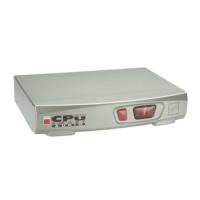
Do you have a question about the Lindy Switch and is the answer not in the manual?
Covers front and rear panel components, indicators, and connectivity options.
Lists items included in the box and additional items that may be needed for setup.
Describes methods for mounting the LINDY KVM IP unit, including rack brackets.
Details on connecting host computers, local consoles, and network ports.
Guides through the initial setup screens for essential details.
Explains the Unit, Network, Modem, and Secure Keys setup screens.
Outlines accessing and configuring the device remotely.
Discusses placing the KVM IP behind or alongside firewalls and routers.
Details port usage, firewall considerations, and IP address assignments.
Steps to configure power ON/OFF strings and sequences for host computers.
Details the structure and hexadecimal codes for power control sequences.
Describes the command-line tool for configuration, host management, and logging.
Provides syntax and examples for using KVMADMIN commands.
Step-by-step instructions for upgrading the unit's firmware.
Explains the three methods for connecting to the device.
Details local connection setup and accessing the control menu.
Describes connecting via VNC viewer or web browser over network or dial-up links.
Describes the menu bar, controls, and other elements of the viewer interface.
Provides advice on screen resolution, navigation, and optimizing performance.
Explains the local and remote mouse cursors and single mouse mode.
Details how to select and switch between connected host computers.
Explains how to auto-calibrate screen and mouse settings for optimal display.
Describes how to remotely switch connected systems on or off.
Details options like single mouse mode, resync, refresh screen, and mouse control.
Adjustments for Phase, Horizontal Position, Vertical Position, and Colour settings.
Explains using Auto buttons and Calibrate All for optimal settings.
How to use the Virtual Media feature for remote file transfer to host computers.
Steps to initiate and establish a connection using a modem or ISDN link.
Explains encryption options for VNC viewers and web browsers.
Lists web browsers tested and confirmed to work with the LINDY KVM IP.
Information on how to get help, including website, email, fax, and phone contacts.
Lists common problems like connectivity and cursor response issues with solutions.
Instructions on how to access the local configuration menus using hotkeys.
Configuration of keyboard layout, unit name, screensaver, encryption, and video source.
Setting the administrator password and selecting hotkey sequences for menu access.
Settings for IP address, subnet mask, gateway, and DHCP server usage.
Configuration of VNC/HTTP ports and IP-based access restrictions.
Configures modem/ISDN connection parameters like IP addresses and baud rate.
Step-by-step instructions for performing a factory reset of the unit's configuration.
Explains the purpose and function of IP access control settings.
Steps to remove all entries from the IP access control list.
Options for optimizing image quality and speed via colour and encoding settings.
Controls for keyboard, mouse, and clipboard data transfer and input modes.
Adjusts how the server screen image fits the viewer window.
How the viewer confirms the authenticity of the LINDY KVM IP unit.
Manages saving and loading viewer connection configurations and defaults.
Overview of window controls, modes, and functions for the VNC viewer.
Explains how to use the Virtual Media feature for file transfer.
Details encoding, colour level, input, security, and misc options for browser viewers.
Instructions on how to access the remote configuration menus via VNC or browser.
Details on creating, naming, setting passwords, and assigning permissions for user accounts.
Displays hardware and firmware version information for the unit.
Configures keyboard layout, admin password, unit name, hot keys, screensaver, and encryption.
Configures timeouts, mouse behavior, and screen refresh rates.
Instructions on how to perform a firmware upgrade.
Options for setting timezone, using NTP, and configuring NTP server IP address.
Steps for adding, reordering, editing, or removing IP access control rules.
Configures modem/ISDN connection parameters like IP addresses and baud rate.
Configures the baud rate for the power control unit serial connection.
Defines host names, permitted users, hotkeys, and power control commands.
Explains how to define hotkey sequences for switching between hosts.
Details the Port Direct system for controlling KVM switches and managing access rights.
How to view, copy, clear, and refresh the unit's activity log.
Explains the structure and purpose of IP addresses.
Explains how net masks define network segments and facilitate communication.
Provides a detailed binary explanation of how net masks operate.
How to set masks for single locations or all available IP addresses.
Explains how to define ranges of IP addresses using masks and blocks.
Explains the role of ports in network connections and directing traffic.
Discusses security issues related to port numbers and firewall configuration.
Provides pinout diagrams for serial mouse converters and power switch cables.
Explains the notation for defining hotkey sequences and special key presses.
Instructions and examples for creating complex hotkey macro sequences.
Lists the video modes supported by the LINDY KVM IP unit.
Safety guidelines for using the unit in dry environments and handling power adapters.